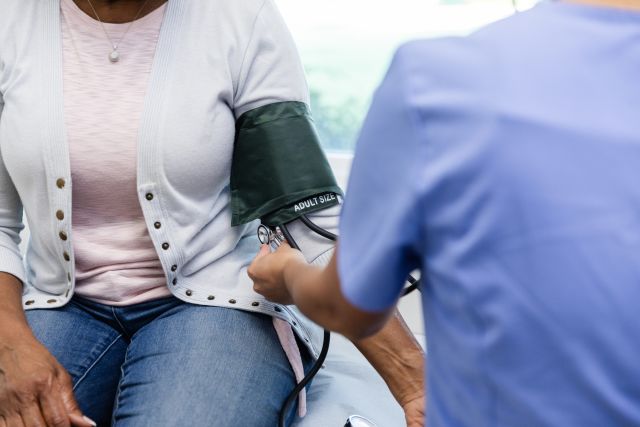Updated on July 14, 2025.
High blood pressure, also called hypertension, can develop without any signs or symptoms. You may not know that you have it, but it could be harming your blood vessels, heart, and even your kidneys and eyes.
Nearly half of adults in the United States (roughly 120 million people) have high blood pressure, but less than one-quarter of them have it under control, according to the Centers for Disease Control and Prevention (CDC).
“Hypertension isn’t something that’s always symptomatic,” says Gregory L. Miller, MD, a cardiologist in Grand Rapids, Michigan. “People aren’t alarmed. They’re feeling fine, so they’re not going to seek medical care.”
Dr. Miller adds that it's important to treat high blood pressure. Even if it is slightly higher than normal, steps should be taken to lower it, he explains.
What is an ideal blood pressure level?
A blood pressure reading has two elements: the top number (systolic) and the bottom number (diastolic). Healthcare providers (HCPs) measure these readings in millimeters of mercury (mm Hg).
A normal blood pressure level is lower than 120/80 mm Hg. A top number of between 120 and 129 and a bottom number higher than 80 is considered elevated, or slightly higher than normal. Anything above 130 on the top or 80 on the bottom is considered high blood pressure.
These are pretty solid guidelines, says Miller, but he also notes that one’s blood pressure can change frequently. Blood pressure is usually highest in the morning when there are more catecholamines—stress hormones like adrenaline—in the blood.
There’s also day-to-day variation based on things like the foods you eat, if you are dehydrated, and the weather. There’s even a phenomenon called “white coat hypertension” where people have higher blood pressure in an HCP's office, possibly due to stress or anxiety around medical appointments.
What increases the risk for high blood pressure?
There are many things that may increase your risk for high blood pressure:
Age
Blood pressure tends to rise for almost everyone as they get older. Around 90 percent of Americans will develop high blood pressure by the time they reach between 55 and 65 years of age. Anyone older than 40 should get their blood pressure checked at least once a year.
Race
In the United States, Black adults are at a greater risk for high blood pressure (56 percent) than Hispanic (39 percent) and non-Hispanic white adults (48 percent), according to the CDC. High blood pressure is also thought to develop at an earlier age in Black people than in other groups.
Sex
Men are more likely to have high blood pressure than women until about age 64 or 65. At that point, women tend to develop the condition more frequently.
Family history
If you have an immediate family member (like a parent or sibling) with high blood pressure, you’re more likely to have it. This may be due to genetics, as well as the environment and lifestyle you share with your family.
What can happen if high blood pressure is not treated?
Untreated high blood pressure can damage artery walls, making it easier for plaque to build up. This can lead to atherosclerosis, a hardening of the arteries that increases your risk for heart attacks, strokes, and heart failure.
High blood pressure can harm kidneys, too. “It’s a big cause and one of the few treatable causes of kidney damage,” Miller says. Kidney damage from high blood pressure is called hypertensive nephropathy.
“Everything—coronary artery disease [the most common type of heart disease], heart failure—gets worse from renal insufficiency [poor kidney function],” says Miller.
The blood vessels in your eyes can be damaged by high blood pressure, as well. This condition is called hypertensive retinopathy. It can potentially lead to double vision, headaches, and even vision loss. High blood pressure also puts you at risk for damage to eye nerves and blockages in the blood vessels that deliver blood to the eyes.
Lifestyle changes can help lower blood pressure
Treatment for high blood pressure usually starts with testing your blood pressure regularly. Your HCP can perform a simple blood pressure test in their office. You can also do it from home or, in many cases, at a local pharmacy.
After each test, make sure to log the readings so you can monitor your blood pressure over time. Use a pen and paper or smartphone app—whatever works best for you. Sharecare, available for iOS and Android, features a handy blood pressure tracker. You can input your readings manually or connect a compatible device and enable automatic tracking.
To start bringing down your blood pressure, changes to diet and exercise are often recommended. Your HCP can create a plan tailored for you to lower blood pressure and improve the effectiveness of other treatments.
“We’ve seen a number of people who have successfully lost weight and their blood pressure gets much better,” says Miller. “And we ask people to limit sodium [salt] because eating too much increases water retention and blood pressure.”
To help manage blood pressure:
Follow a well-balanced, low-salt eating plan like the DASH Diet
Try to eat more fruits and vegetables but limit salt, sugar, and saturated fats, like butter, which are solid at room temperature.
Limit or avoid alcohol
The healthiest amount of alcohol is none. If you drink, do so in moderation. Men should limit themselves to two alcoholic drinks per day. Women should have no more than one.
Get regular exercise
Most adults should get at least 150 minutes of moderate-intensity physical activity each week, or at least 75 minutes of vigorous-intensity activity. They should also do muscle-strengthening exercises at least twice a week. But all movement counts and has health benefits. So, try to simply move more as you are able each day.
Take steps to manage stress
It may be tough to ease stress if you are facing difficulties, like medical problems, or if you have a lot on your mind. But small acts of self-care can help you cope. This might include reaching out to your friends or family for support, taking a short walk to get some air, taking a quick break to listen to a song, or making a point to try and get some extra sleep.
Maintain a healthy body weight
One of the best ways to manage your weight is to eat more fruits and vegetables and fewer processed foods and sugary drinks. Trying to be active each day and sticking to a regular sleep schedule (going to bed and waking up around the same time each day) can also help control your hunger and cravings.
Consider your salt consumption
The American Heart Association (AHA) recommends limiting your salt intake to 2,300 milligrams (mg) per day, roughly equivalent to 1 teaspoon of salt. To control or prevent high blood pressure, some people may need to consume less than this, around 1,500 mg per day or less.
For some people, diet and exercise might not be enough to reduce high blood pressure. “Most people need medication,” Miller says. There are several different medications that can help. An HCP can provide advice and recommendations.







